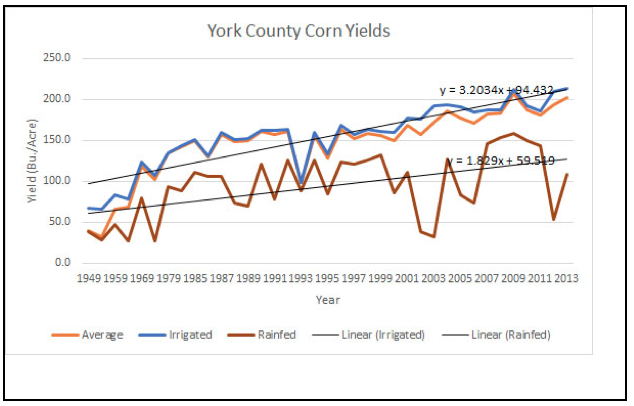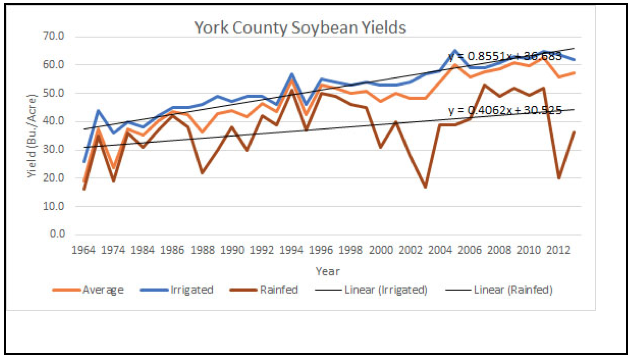Coming Events
10/26/2014 – 5:00 p.m., 4-H Achievement Party, York County Fairgrounds, York
10/27/2014 – 8:30 p.m., Extension Board Meeting, Extension Office, York
Cropping Update
Generally this was a great week for producers, they were able to continue harvesting most of the time. The .10†of rain Sunday evening will not slow them down much. With producers finally making some great progress getting those soybeans harvested, I want to remind them to be sure to take time to note fields that had poorer than expected yields (not from hail or flooding damage) and then plan to collect soil samples for soybean cyst nematodes (SCS). It is estimated that Nebraska soybean growers lost $45 million dollars last year from the pest, we’ll lose less this year only because of the lower prices for soybeans not because we’ve solved the problem.
SCN attacks the roots of soybeans and can have a devastating effect on yields. Our specialists indicate that if you took the yield losses of all other soybean diseases in Nebraska, the total would be much less than the losses caused by SCN. Yields can be reduced by 20-30% and you’ll see no visual signs.
What makes SCN such a problem is yields can be reduced 20 to 30 percent with no visual signs on the plant. The first indication of an SCN infestation is often soybean yields that seem to hit a plateau or even start decreasing…..while corn yields in the same field continue to increase. SCN will complete life cycle in about 25 to 30 days. They are very tiny and only cysts, or swollen female full of several hundred eggs, can be seen on the outside of the roots.
The best way to determine if you have a SCN problem in your fields is to take a soil test which you can do any time of the year, but typically the best time is after harvest:
Other farm activities are not as demanding.
This is typically when soil samples are taken for the following year’s fertilizer recommendations. Simply take a few more soil probe cores from and send off for SCN analysis.
Poor yielding soybean fields, or even areas within a field, are fresh in your mind and can help you identify fields or areas you want to sample. Yield maps can also be very helpful.
When sampling a soybean field, pull your samples a couple inches to the side of the old soybean row. This way you are sampling through the root system and you are more likely to detect SCN if it is there. If sampling a corn field or other crop residues that will be going to soybeans next year, just take random samples. The advantage of doing this is, if you detect SCN in your fields, you can select varieties resistant to SCN.
The cost for a soil analysis is about $25 per sample, but since 2005, the Nebraska Soybean Board has provided funding so there is no cost to Nebraska farmers, field scouts or others submitting a soil sample for SCN analysis. We have sample bags for your free SCN analysis here at the UNL Extension office.
So, if you discover SCN in your fields and switch to a resistant variety, there is no tech fee for the SCN resistance and the variety tests conducted in Nebraska show yields comparable to top yielding susceptible varieties. The past 8 years research trials have shown an average 6-bushel yield advantage for SCN-resistant varieties in SCN-infested field when compared to top yielding susceptible varieties.
I’ve got several sample bags and instructions available at our office, stop by and pick some up. If you’d want me to drop them off for you when I go to Lincoln, I’d be glad to also do that.
Earlier I mentioned soybean fields that plateau or go down in yields? What have your corn and soybean yields been trending? I’ve tried to keep track of the average York County NASS corn and soybean yields and have charted them for the past several years. Since 1949 irrigated corn yield trend line has been increasing at about 3.2 bu./acre/year while irrigated soybeans have been increasing at .86 bu./acre/year. Nebraska irrigated corn and soybean yields have been increasing at a slightly lower rate of 3.09 & .80 bu./acre/year. How have your yield been trending?
Finally, I know that with all the hail we’ve experienced this past summer, we’re going to have questions about harvesting, drying, storing late-maturing, high-moisture corn. This week on our CropWatch website, Ken Hellevang, North Dakota State University Extension Service agricultural engineer shared some tips for addressing these issues. Check out the story at http://cropwatch.unl.edu along with links to many other grain storage and management information.
Let me know if I can be of help to you regarding these issues. Good luck as you continue to get this years crop harvested.
Returning to the Farm
I mentioned it last week, but wanted to remind area producers again that UNL will be offering “Returning to the Farm†workshop held over two weekends. The first weekend sessions will be Dec. 12 & 13th and the second Jan. 9 & 10th.
During the program participants will:
Review financial feasibility, balance sheets and trend sheets
Identify estate planning issues
Develop a farm/ranch transition plan
Set both personal and professional goals
Look at the communication process between family members
Returning to the farm is sponsored by the University of Nebraska – Ag Economics Department. Presenters will include: Dave Aiken, Tina Barrett, Kate Brooks, Dave Goeller, Cheryl Griffith, Brad Lubben, Jay Parsons, Cory Walter and Roger Wilson.
Information about this workshop is posted on our website: http://york.unl.edu/crops-future.
National Food Entrepreneur Program Seminar
The University of Nebraska Food Processing Center is offering a one-day seminar for all individuals interested in exploring the idea of starting a food manufacturing business. Please encourage interested individuals in your community to attend the “Recipe to Reality†seminar which will be offered on November 15, 2014. Pre-registration is required and space is limited. Registration deadline is November 1, 2014. Contact Jill Gifford at 402-472-2819 or jgifford1@unl.edu for an information packet.
Yard and Garden Update
Do you have dandelions or other broadleaf weeds in you cool season turf? If so, we are now in the prime season for broadleaf weed control which started about September 15, but there is plenty of time in the fall for good, if not even improved, control over earlier applications. Applications made now have very little chance of affecting near dormant trees and ornamentals, unlike with spring applications made around non-target species that are leafing out and/or blooming. For the latest information about fall broadleaf weed control, check out the latest Turf iNfo at: http://turf.unl.edu/. If you have the time also take their survey to help them improve the information they’re providing. If you have some ideas for topics, please share them when you take the survey.



































